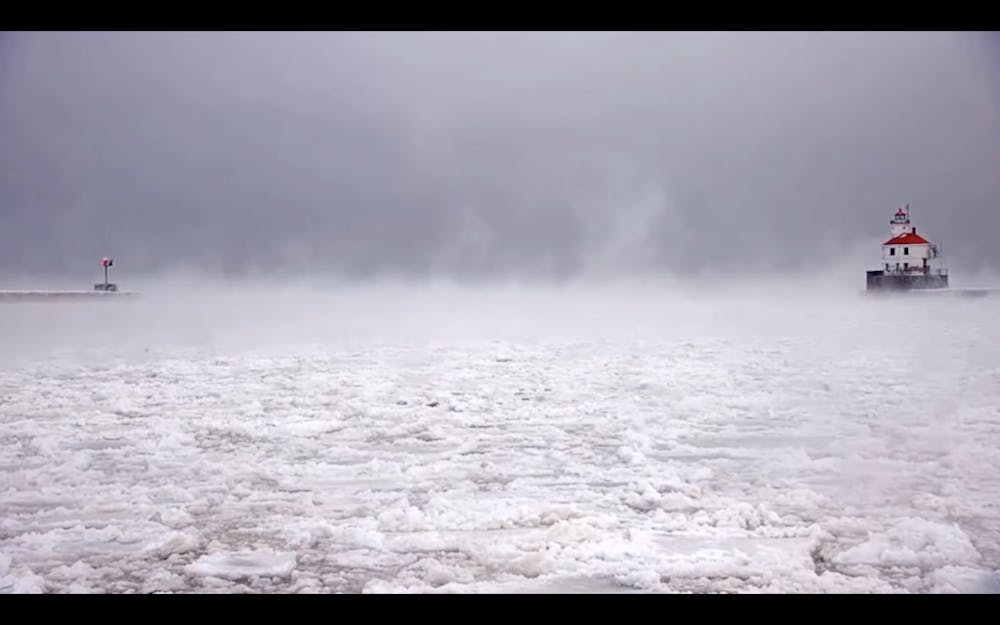The graduating class from Duke’s Master of Fine Arts in experimental and documentary arts program have begun showcasing their thesis projects in the program’s annual thesis exhibition, with student work on view across Duke and Durham at the Power Plant Gallery, Full Frame Theater, Shadowbox Studio, The Fruit, Screen/Society and the Rubenstein Arts Center. The exhibition highlights the work of seven artists: Lily Frame, Emma Geiger, Taoyuan Jin, Emily MacDiarmid, Shirin Maleki, Ivy Nicole-Jonét and Nathan Borradaile Wright.
The Chronicle sat down for an interview with Maleki. Born in Tehran, Iran, Maleki studies experimental storytelling, photography, poetry and animation. In her thesis project, 30/900, Maleki explores the realities of immigration through liminal spaces drawn from livestream footage and spoken word.
The interview has been edited for length and clarity.
The Chronicle: I would love to start with an introduction of yourself and your project.
Shirin Maleki: I did my undergrad at the Art Institute of Chicago. I worked for a couple years in Germany as a media designer, and then I came to Duke for my graduate studies. The transition between Germany and here with the two years of pandemic were particularly difficult because of the VISA situation, everything that was happening with Trump and everything that was happening to people who looked like me. This piece comes from those hardships. I have been writing these things forever but I never wanted to share them with anyone. Doing this program, people really pushed me and helped me to be confident.
TC: Would you call this piece autobiographical then?
SM: It is autobiographical but I don’t think it is specific to me. I have friends who are outside their home country. The things I talked about, they know it, even if they can’t say it. I am sure they feel it.
TC: Something I loved was walking into this screening room and how the physical space interacted with your film. Why this space for your film?
SM: I wanted the piece to be hidden, enveloped in a safe embrace. I wanted it to be a journey to get to see it. I want you to have to move your body to see it. Pay a little price just to get here because they are so personal. The structure is like parentheses, holding something inside.
TC: Can you talk a little about what you wrote for this piece, the themes you were exploring?
SM: I think it is a looking back at the loss of everyday life, not looking back in a sad way but looking back and reflecting. [I thought] about language; people who speak more than one language and who are stronger in one yet begin to lose it. You think that [language] is something that you will have forever. I talk about body politics, looking at the experiences immigrants face more than other people. I look at repetition as a theme, like the advantage of having a routine that takes years to build. One is about distance, time, and space. And, the last is about missed landscapes other than visuals.
TC: One of my favorite parts was the house with lights coming on. I think comparing it to dreaming, these small glimmers of light in windows, was profound. How did you ultimately decide which visuals to pair with your writing?
SM: The process was very important in creating this. One thing that I started to be obsessed with was live streaming. All of the videos were screen-recordings of live streams in different parts of the world. That specific scene you are talking about is an apple orchard. That is because of my connection to my parents, who have a little apple orchard at home. So, I found an apple orchard that live streams every day, and that’s the moment they wake up and go to work.
TC: That is fascinating. I had no idea that it was a live stream.
SM: It makes it easy and hard at the same time because you have to find what you want. There are so many websites where you can select which country you want to see. I have lived in so many countries, and sometimes, I just miss those places.
TC: Why live stream? What was the purpose of using live streams versus using something like archival footage?
SM: It comes from my experience on screens and how I am so dependent on my phone and my connection with my family. The screen is so much more than a digital thing; it becomes physical.
TC: You also included written word, not just spoken word. Why both? And why have the words reflect, going from right to left?
SM: The mirroring comes from the structure in which people can watch from both sides [of the screen]. It also comes from the fact that Farsi is written from right to left. That is the struggle of an immigrant whose language is not Latin alphabet. Suddenly, you look at your own language, and you don’t recognize it.
TC: What are your plans for the future after the conclusion of this project?
SM: Right now, I am planning to go to a Ph.D. program [in Communications, Rhetoric, & Digital Media] at NCCU. I am going to keep creating work. The great thing about the program is that they understand that I am an artist. They are really accommodating to me being able to write, make and be a scholar.
Maleki’s project will be on view from until April 15 at the Rubenstein Arts Center.
Get The Chronicle straight to your inbox
Signup for our weekly newsletter. Cancel at any time.

